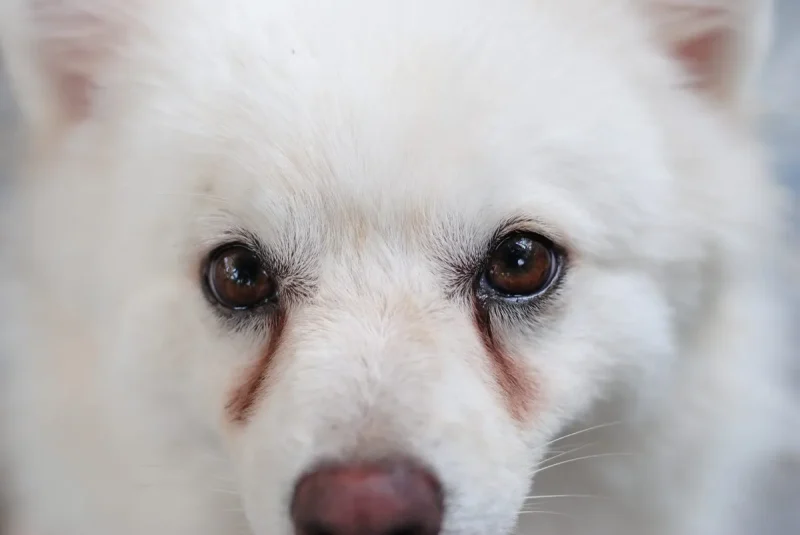Tear stains are dark brown or reddish streaks beneath a dog’s eyes, which are more common in certain breeds than others. They can result from various causes, ranging from normal tear production to underlying infections. While these stains are often a natural trait of specific breeds, it’s important to consult a veterinarian or eye specialist if your dog develops them. A professional can determine whether the cause is treatable. They can also offer you advice on how to prevent and clean dog tear stains.
Why does my dog have tear stains?
The discoloration in dog tear stains is caused by porphyrin, iron-containing molecules found in tears. A common misconception is that tear stains result only from excessive tearing. However, even a normal amount of tear production can cause staining. When porphyrin comes into contact with white fur, it produces a reddish tint.
All dogs have porphyrin in their tears, but the staining is more noticeable in breeds with white or light-colored fur than those with dark fur. This same molecule is also present in saliva, which is why dogs that frequently lick their paws may develop a similar reddish-brown discoloration in those areas.
In some cases, tear stains may be caused by epiphora, a condition characterized by excessive tear production or an inability to properly drain tears. Epiphora can be either acute or chronic and is often linked to underlying issues such as allergies, dry eye syndrome, or a blocked tear duct. In many cases, veterinary treatment can help address the root cause.
Causes of dog tear stains
The causes of dog tear stains vary widely, from eye conditions to fungus. Beyond the typical porphyrin-induced tear staining, yeast can also be a culprit. A brownish yeast, often mistakenly called “Pytrosporin” (its actual name is Malassezia), can thrive on a dog’s face and other damp areas. This yeast can also show up around the eyes, sometimes being mistaken for regular tear stains. However, yeast-related staining and porphyrin-induced staining are entirely different issues with different treatment plans.
Conjunctivitis or glaucoma can also lead to tear staining, as can conditions such as inverted eyelids, ingrown eyelashes, stress, diet, and the shallow eye sockets commonly found in brachycephalic breeds.
Brachycephalic dogs tend to have shallow eye sockets, which can cause the eyes to bulge. Sometimes the eyelids can’t fully close, leaving the eyes exposed to irritants, dryness, and damage. You may especially notice the inability to fully close the eyelids when your dog sleeps The Shih-Tzu, Pekingese, Maltese, and Pug are among the short-nosed breeds that commonly develop eye problems.
Poodles and Cocker Spaniels, along with other breeds, are more genetically likely to have imperforate puncta, a condition where the holes near the eyes that drain tears do not properly develop. This causes tears to build up, and stains are more likely to form.
How to treat dog tear stains
Treatment for dog tear stains depends on the underlying cause. If your dog has an eye condition causing excess tearing, then this should be addressed. Your veterinarian can diagnose and offer solutions for how to deal with a medical condition. If the cause is an irritant, you can flush your dog’s eyes with water to help reduce tear production. However, if there’s an eye infection causing the epiphora, your veterinarian may prescribe antibiotics.
Surprisingly, diet and stress can play more of a factor in dog tear stains than you might think. Diets high in iron can increase the amount of reddish tint due to increased levels of iron. Your dog may also have a food sensitivity causing an eye-watering as allergic reaction. You may want to start your dog on a hypoallergenic diet and see if there are any positive results. Do not switch to a grain-free diet without talking to your vet, as it may be linked to certain heart conditions. Some vets may recommend a supplement like this one to aid with epiphora. You can also find wipes specifically formulated to help clean dog tear stains.
As for removing the stains, many products on the market claim to do so. Usually, these are a waste of money and can even be harmful to your dog. Generally, wiping away the tears frequently will reduce the presence of porphyrin, the pigment that causes staining, as well as any yeast infections that might occur. You can clean the fur with colloidal silver, which is safe near the eyes.
How to prevent dog tear stains
There are some things you can do to prevent your dog from getting tear stains. Preventing them will help you from having to clean dog tear stains later. Keep the fur around the eyes trimmed so that it doesn’t cause irritation. Wipe the area affected by excess tears with a paper towel soaked in warm water.
You’ll want to keep a dog-safe eyewash to remove irritants. Keep this on hand during allergy season and if your dog has had a good play session outside and you notice them stretching at their eyes. You may also want to carry a handkerchief or soft towel to dab beneath your dog’s eyes throughout the day. It may take a few weeks before you see a reduction in tear stains, but over time, this will help.
Some suggest that switching to filtered water can help, as well as adding apple cider vinegar to your dog’s food, though you should consult your vet to determine the right amount to add. You’ll also want to toss those plastic food and water bowls, as they can crack and harbor bacteria which can lead to irritation and subsequent staining. Products that are not safe around the eyes include hydrogen peroxide, topical vinegar, and makeup remover. Do not use these products near your dog’s eyes.

